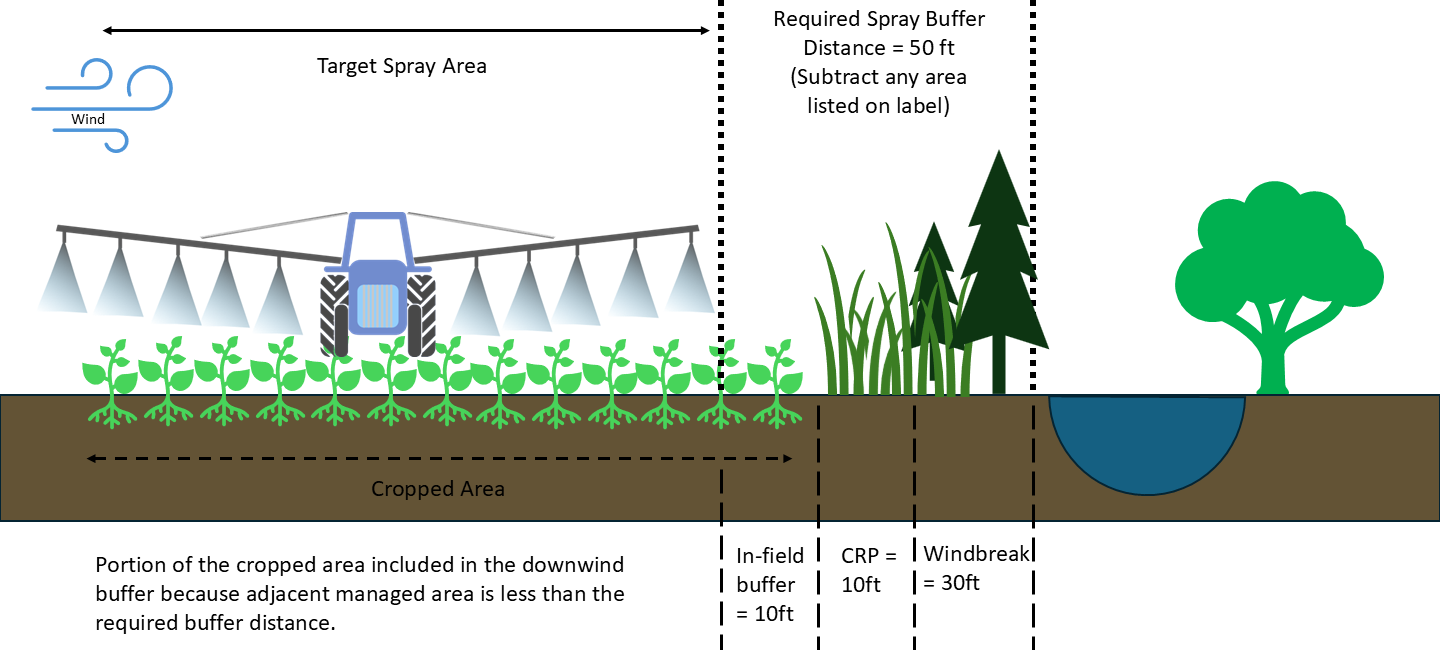
The U.S. Environmental Protection Agency (EPA) is implementing mandatory Endangered Species Act (ESA) spray drift mitigations on pesticide labels. To reduce potential impacts to listed species, requirements may include:
- Restricting the maximum windspeed to 10 to 15 miles per hour.
- Prohibiting applications during temperature inversions.
- Boom length restrictions and swath displacements for aerial applications.
- Maximum release heights for ground and aerial applications.
- Directing sprays into the canopy for airblast and turning off the outer nozzles at the last row.
- Downwind buffers ranging from 10 to 320 feet depending on a pesticide's potential for population-level impacts.
Some application types such as chemigation, in-furrow sprays when nozzle height is less than 8 inches above soil surface, tree trunk drench, tree trunk paint, and tree and soil injection may not require additional buffers due to low risk. Not all buffers required on labels are due to ESA requirements. Always read and follow the label.
Buffer Reductions
ESA language on pesticide labels will require applicators to visit the EPA Mitigation Menu website. This website will walk applicators through a series of steps to determine if buffers are required and provide options to reduce buffer distance up to a 100% depending on the choices implemented. The mitigation options may include:
- Reducing application rate,
- Increasing droplet size,
- Reducing the proportion of the field treated,
- Accounting for adjacent off-field features such as hedgerows, windbreaks, other managed land and farm infrastructure.
Product labeling for the specific application type must be followed when implementing buffers and when using the mitigation menu to reduce the buffer distance.
Buffer Zones
The figures below depict two scenarios where a 50-foot buffer is required between an agricultural field and an aquatic habitat. In the first scenario, the buffer can be reduced 100% because there is 50 feet of managed land (30-foot windbreak and 20 feet of CRP) between the edge of the field and the aquatic habitat. In the second scenario, the buffer is only reduced by 80%. There is still a 30-foot windbreak but only 10 feet of CRP, totaling 40 feet of managed land between the edge of the field and the aquatic habitat. This results in a 10-foot in-field buffer being needed to meet the required 50-foot buffer.
Click on each of the images below to enlarge.


Managed Areas That Can Be Included in ESA Buffers
The following managed areas may be included in the required buffer if they are immediately adjacent or contiguous to the treated area in the downwind direction and people are not present in those areas. Label requirements restricting drift in any of these areas must be followed.
- Agricultural fields, pastures, forage fields, and private rangelands, including untreated portions of the treated field;
- Roads, paved or gravel surfaces, mowed grassy/fallowed areas adjacent to field, and areas of bare ground from recent plowing or grading that are contiguous with the treated area;
- Buildings and their perimeters, silos, or other man-made structures with walls and/or roof;
- Areas present and/or maintained as a runoff/erosion measure as listed on EPA’s Mitigation Menu website. Examples include vegetative filter strips (VFS), field borders, grassed waterways, vegetated ditches, riparian areas, managed/constructed wetlands, or other areas of intentional habitat improvement;
- Areas present and/or maintained as a drift buffer reduction measure as listed on EPA’s Mitigation Menu website. Examples include vegetative windbreaks, hedgerows, shelterbelts, riparian areas, private forests, woodlots, and shrublands;
- Conservation Reserve Program (CRP) and Agricultural Conservation Easement Program (ACEP) lands (applicators may need to ensure that pesticide use does not cause degradation of the CRP habitat).
- On-farm contained irrigation water resources that are not connected to adjacent water bodies, including on-farm irrigation canals and ditches, water conveyances, managed irrigation/runoff retention basins, farm ponds, and tailwater collection ponds.
The EPA has developed a Spray Drift Calculator, and the Pesticide App for Label Mitigations (PALM), a mobile-friendly website, to help applicators determine drift mitigation needs.
Last Updated: 7/17/2025

